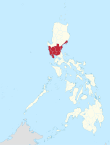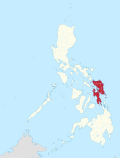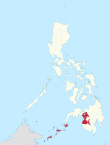Regions of the Philippines
Administrative divisions of the Philippines From Wikipedia, the free encyclopedia
In the Philippines, regions (Filipino: rehiyon; ISO 3166-2:PH) are administrative divisions that primarily serve to coordinate planning and organize national government services across multiple local government units (LGUs). Most national government offices provide services through their regional branches instead of having direct provincial or city offices. Regional offices are usually but not necessarily located in the city designated as the regional center.
| Regions of the Philippines | |
|---|---|
 Administrative map of the Philippines | |
| Category | Region |
| Location | Philippines |
| Number | 18 (as of 2024) |
| Possible status |
|
| Populations | Smallest: 1,791,121 (CAR) Largest: 16,139,770 (Calabarzon) |
| Areas | Smallest: 636.00 km2 (245.56 sq mi) (NCR) Largest: 29,620.90 km2 (11,436.69 sq mi) (Mimaropa) |
| Government |
|
| Subdivisions | |
As of 2024, the Philippines is divided into 18 regions. Seventeen of these are mere administrative groupings, each provided by the president of the Philippines with a regional development council (RDC) – in the case of the National Capital Region (Metro Manila), an additional metropolitan development authority serves as the coordinating and policy-making body. Only one, the Bangsamoro Autonomous Region in Muslim Mindanao, has an elected government and parliament to which the Congress of the Philippines has delegated certain powers and responsibilities.
History
Summarize
Perspective
Regions first came to existence on September 24, 1972, when the provinces of the Philippines were organized into eleven regions under Presidential Decree No. 1 as part of the Integrated Reorganization Plan of President Ferdinand Marcos.[1] Since that time, other regions have been created and some provinces have been transferred from one region to another.
Timeline
- June 22, 1973 – Pangasinan is transferred from Region III (Central Luzon) to Region I (Ilocos Region).[2]
- July 7, 1975 – Region XII is created, and some regions of Mindanao are reorganized.[3]
- July 25, 1975 – Regions IX and XII are declared as Autonomous Regions in Western and Central Mindanao, respectively.[4]
- August 21, 1975 – Region IX is divided into Sub-Region IX-A and Sub-Region IX-B. Some regions in Mindanao are reorganized.[5]
- November 7, 1975 – Metro Manila is created.[6]
- January 23, 1976 – Metro Manila is separated from Southern Tagalog to become Region IV; Southern Tagalog becomes Region IV-A.[7]
- June 2, 1978 – Metro Manila is declared the National Capital Region.[8]
- June 11, 1978 – The regional center of Region IX is transferred from Jolo, Sulu to Zamboanga City.[9]
- July 15, 1987 – The Cordillera Administrative Region is created.[10]
- August 1, 1989 – The Autonomous Region in Muslim Mindanao (ARMM) is created.[11] Region XII reverted to an administrative region.
- January 30, 1990 – Residents reject in a plebiscite the ratification to create the Cordillera Autonomous Region.[12]
- October 12, 1990 – Reorganization and/or renaming of the Mindanao regions: Region IX (Western Mindanao), Region X (Northern Mindanao), Region XI (Southern Mindanao), Region XII (Central Mindanao), and ARMM. Regional center of Region IX is transferred to Pagadian, with Zamboanga City remaining as the region's commercial and industrial center.[13]
- February 23, 1995 – Region XIII (Caraga) is created and minor reorganization of some Mindanao regions; Sultan Kudarat is transferred to Region XII.[14]
- March 7, 1998 – Residents reject in a plebiscite for the second time the ratification to create the Cordillera Autonomous Region.[15]
- December 18, 1998 – Sultan Kudarat is reverted to Region XII.[16]
- March 31, 2001 – The ARMM is expanded.[17]
- September 19, 2001 – Most Mindanao regions are reorganized and some are renamed, such as Region IX (Zamboanga Peninsula), Region XI (Davao Region), and Region XII (Soccsksargen).[18]
- May 17, 2002 – Region IV-A (Calabarzon) and Region IV-B (Mimaropa) are created from the former Region IV (Southern Tagalog) region; Aurora is transferred to Region III.[19]
- October 28, 2003 – Calamba, Laguna is designated as the regional center of Region IV-A.[20]
- March 30, 2004 – Koronadal is designated as the regional center of Region XII.[21]
- May 23, 2005 – Palawan is transferred from Region IV-B to Region VI (Western Visayas).[22]
- August 19, 2005 – The transfer of Palawan to Region VI is held in abeyance.[23]
- November 22, 2007 – Calapan is designated as the regional center of Region IV-B.[24]
- May 29, 2015 – The Negros Island Region (NIR) is created. Negros Occidental and Bacolod are transferred from Region VI, and Negros Oriental is removed from Region VII (Central Visayas).[25]
- July 17, 2016 – The Southwestern Tagalog Region (Mimaropa Region) is established comprising the former Region IV-B (in effect merely a renaming and discontinuation of the "Region IV-B" designation since no boundary changes were involved).[26]
- August 7, 2017 – The NIR is abolished. Negros Occidental (including Bacolod) and Negros Oriental are reverted to Regions VI and VII, respectively.[27]
- January 25, 2019 – The Bangsamoro Autonomous Region in Muslim Mindanao (BARMM) is created, replacing the ARMM after the ratification of the Bangsamoro Organic Law.[28][29][30]
- June 11, 2024 – The NIR is re-established, with Siquijor transferred from Region VII.[31][32]
- September 9, 2024 – Sulu is declared not part of the BARMM.[33]
List of regions
Summarize
Perspective
As of June 30, 2024[update], the Philippines is divided into 18 regions.[34] The traditional island groups of Luzon, the Visayas, and Mindanao are composed of eight (Regions I, II, III, IV-A, and V, and CAR, NCR, and Mimaropa), four (VI, VII, VIII, and NIR), and six (IX, X, XI, XII, XIII, and BARMM) regions, respectively. The names of Calabarzon, Mimaropa, and Soccsksargen are acronyms signifying their component provinces and cities; and are usually capitalized in official government documents.
Types of regions
Administrative region
An administrative region is a grouping of geographically adjacent LGUs that may be established, disestablished, and modified by the president of the Philippines based on the need to formulate coherent economic development policies, more efficiently provide national government services, and coordinate activities beneficial to the development of larger area beyond the province level. No plebiscites have been conducted so far to democratically confirm the creation, abolition or alteration of the boundaries of regular administrative regions, as the Constitution does not mandate it.[35]
An administrative region is not a local government unit (LGU), but rather a group of LGUs to which the president[36] has provided an unelected policy-making and coordinating structure, called the Regional Development Council (RDC).[37] Metro Manila is recognized in law as a "special development and administrative region", and was thus given the Metropolitan Manila Development Authority (MMDA);[38] the Metro Manila Council within the MMDA serves as the National Capital Region's RDC.[37]
Autonomous region
The 1987 Constitution allows for the creation of autonomous regions in the Cordillera Central of Luzon and the Muslim-majority areas of Mindanao.[35] However, only the Bangsamoro Autonomous Region in Muslim Mindanao and its predecessor, the Autonomous Region in Muslim Mindanao, have been approved by voters in plebiscites held in 1989, 2001, and 2019. Voters in the Cordilleras rejected autonomy in 1990 and 1998; hence the Cordillera Administrative Region remains as a regular administrative region with no delegated powers or responsibilities.
The Supreme Court has ruled that an autonomous region established by statute must be composed of more than one province, thereby invalidating the proposed establishment of the Autonomous Region of Ifugao following the results of the original 1990 Cordillera autonomy plebiscite, which saw only Ifugao's voters casting a majority 'yes' vote towards autonomy.[39]
Table of regions
- Component local government units: the data column is limited to primary LGUs, which pertains to component provinces, highly urbanized cities, and independent component cities, as well as the independent municipality of Pateros. All city names, except those under the National Capital Region, are italicized.
- Location: the location map column can be sorted from north-to-south, west-to-east.
| Location | Region (regional designation) |
PSGC[40] | Island group |
Regional center |
Component local government units |
Area[a] | Population (2020)[44] |
Density | |
|---|---|---|---|---|---|---|---|---|---|
 |
National Capital Region (NCR) |
13 | Luzon | Manila | 636.00 km2 (245.56 sq mi) |
13,484,462 (12.41%) |
20,247/km2 (52,440/sq mi) | ||
 |
Cordillera Administrative Region (CAR) |
14 | Luzon | Baguio | 19,422.03 km2 (7,498.89 sq mi) |
1,791,121 (1.65%) |
89/km2 (230/sq mi) | ||
 |
Ilocos Region (Region I) |
01 | Luzon | San Fernando | 13,012.60 km2 (5,024.19 sq mi) |
5,292,297 (4.87%) |
386/km2 (1,000/sq mi) | ||
 |
Cagayan Valley (Region II) |
02 | Luzon | Tuguegarao | 28,228.83 km2 (10,899.21 sq mi) |
3,679,748 (3.39%) |
122/km2 (317/sq mi) | ||
 |
Central Luzon (Region III) |
03 | Luzon | San Fernando | 22,014.63 km2 (8,499.90 sq mi) |
12,387,811 (11.40%) |
510/km2 (1,320/sq mi) | ||
 |
Calabarzon (Region IV-A) |
04 | Luzon | Calamba | 16,873.31 km2 (6,514.82 sq mi) |
16,139,770 (14.85%) |
854/km2 (2,213/sq mi) | ||
 |
Southwestern Tagalog Region (Mimaropa)[d] |
17 | Luzon | Calapan | 29,620.90 km2 (11,436.69 sq mi) |
3,212,287 (2.96%) |
100/km2 (259/sq mi) | ||
 |
Bicol Region (Region V) |
05 | Luzon | Legazpi | 18,155.82 km2 (7,010.00 sq mi) |
6,067,290 (5.58%) |
319/km2 (827/sq mi) | ||
 |
Western Visayas (Region VI) |
06 | Visayas | Iloilo City | 12,750.63 km2 (4,923.05 sq mi) |
4,730,771 (4.35%) |
371/km2 (961/sq mi) | ||
 |
Negros Island Region (NIR) |
18 | Visayas | Bacolod and Dumaguete (interim/de facto) |
13,525.56 km2 (5,222.25 sq mi) |
4,760,340 (4.38%) |
352/km2 (912/sq mi) | ||
 |
Central Visayas (Region VII) |
07 | Visayas | Cebu City | 10,114.52 km2 (3,905.24 sq mi) |
6,545,603 (6.02%) |
647/km2 (1,676/sq mi) | ||
 |
Eastern Visayas (Region VIII) |
08 | Visayas | Tacloban | 23,251.10 km2 (8,977.30 sq mi) |
4,531,512 (4.17%) |
191/km2 (495/sq mi) | ||
 |
Zamboanga Peninsula (Region IX) |
09 | Mindanao | Pagadian | 17,056.73 km2 (6,585.64 sq mi) |
3,862,588 (3.55%) |
213/km2 (551/sq mi) | ||
 |
Northern Mindanao (Region X) |
10 | Mindanao | Cagayan de Oro | 20,496.02 km2 (7,913.56 sq mi) |
5,007,798 (4.61%) |
229/km2 (593/sq mi) | ||
 |
Davao Region (Region XI) |
11 | Mindanao | Davao City | 20,357.42 km2 (7,860.04 sq mi) |
5,223,802 (4.81%) |
245/km2 (634/sq mi) | ||
 |
Soccsksargen (Region XII) |
12 | Mindanao | Koronadal | 22,513.30 km2 (8,692.43 sq mi) |
4,351,773 (4.0%) |
202/km2 (523/sq mi) | ||
 |
Caraga (Region XIII) |
16 | Mindanao | Butuan | 21,478.35 km2 (8,292.84 sq mi) |
2,795,340 (2.57%) |
121/km2 (313/sq mi) | ||
 |
Bangsamoro (BARMM)[g] |
19 | Mindanao | Cotabato City | 11,935.7 km2 (4,608.4 sq mi) |
3,944,692 (3.63%) |
330/km2 (856/sq mi) | ||
Notes
| |||||||||
Judicial regions
As far as the judiciary is concerned, specifically the first and second level courts, the country is divided into judicial regions as provided by Batas Pambansa Bilang 129. The coverage of these judicial regions generally coincides with that of the administrative regions in 1980, with some exceptions.
Legislative districts
Representation for the Interim Batasang Pambansa was mostly through parliamentary districts based on how regions were organized in 1978. Metro Manila was "Region IV", while Southern Tagalog was "Region IV-A". This was the only time the national legislature was represented via regions; in a 1984 plebiscite, voters approved a constitutional amendment that reverted to representation per province and city.
Proposed regions
- Cordillera Autonomous Region[45] (proposal to convert the Cordillera Administrative Region into an autonomous region; see Cordillera autonomy movement)
- Samar Administrative Region[46]
- Bangsa Sug[47][48][49] or Basulta Autonomous Region[50] (proposed to separate the Sulu Archipelago from the mainland portion of Bangsamoro)
Defunct regions
The following are regions that no longer exist, listed along with their current status:
- Southern Tagalog (Region IV, now divided into Calabarzon, Central Luzon (Aurora), Metro Manila (several cities that were part of Rizal), and Mimaropa; the name remains as a cultural-geographic region only)
- Western Mindanao (renamed as Zamboanga Peninsula, still designated as Region IX)
- Central Mindanao (now mostly Soccsksargen, still designated as Region XII)
- Southern Mindanao (now mostly Davao Region, still designated as Region XI)
- Autonomous Region in Muslim Mindanao (replaced by Bangsamoro)
See also
References
External links
Wikiwand - on
Seamless Wikipedia browsing. On steroids.
